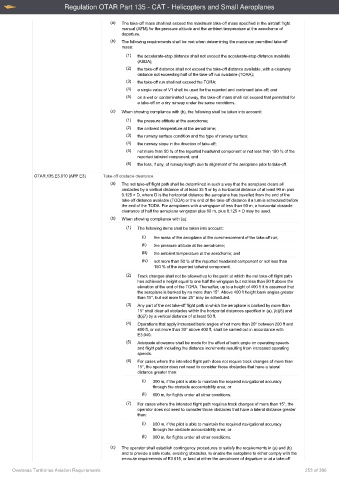Page 253 - Overseas Territories Aviation Requirements Consolidated - Total AOC
P. 253
Regulation OTAR Part 135 - CAT - Helicopters and Small Aeroplanes
(a) The take-off mass shall not exceed the maximum take-off mass specified in the aircraft flight
manual (AFM) for the pressure altitude and the ambient temperature at the aerodrome of
departure.
(b) The following requirements shall be met when determining the maximum permitted take-off
mass:
(1) the accelerate-stop distance shall not exceed the accelerate-stop distance available
(ASDA);
(2) the take-off distance shall not exceed the take-off distance available, with a clearway
distance not exceeding half of the take-off run available (TORA);
(3) the take-off run shall not exceed the TORA;
(4) a single value of V1 shall be used for the rejected and continued take-off; and
(5) on a wet or contaminated runway, the take-off mass shall not exceed that permitted for
a take-off on a dry runway under the same conditions.
(c) When showing compliance with (b), the following shall be taken into account:
(1) the pressure altitude at the aerodrome;
(2) the ambient temperature at the aerodrome;
(3) the runway surface condition and the type of runway surface;
(4) the runway slope in the direction of take-off;
(5) not more than 50 % of the reported headwind component or not less than 150 % of the
reported tailwind component; and
(6) the loss, if any, of runway length due to alignment of the aeroplane prior to take-off.
OTAR.135.E3.010 (APP E3) Take-off obstacle clearance
(a) The net take-off flight path shall be determined in such a way that the aeroplane clears all
obstacles by a vertical distance of at least 35 ft or by a horizontal distance of at least 90 m plus
0.125 × D, where D is the horizontal distance the aeroplane has travelled from the end of the
take-off distance available (TODA) or the end of the take-off distance if a turn is scheduled before
the end of the TODA. For aeroplanes with a wingspan of less than 60 m, a horizontal obstacle
clearance of half the aeroplane wingspan plus 60 m, plus 0.125 × D may be used.
(b) When showing compliance with (a):
(1) The following items shall be taken into account:
(i) the mass of the aeroplane at the commencement of the take-off run;
(ii) the pressure altitude at the aerodrome;
(iii) the ambient temperature at the aerodrome; and
(iv) not more than 50 % of the reported headwind component or not less than
150 % of the reported tailwind component.
(2) Track changes shall not be allowed up to the point at which the net take-off flight path
has achieved a height equal to one half the wingspan but not less than 50 ft above the
elevation of the end of the TORA. Thereafter, up to a height of 400 ft it is assumed that
the aeroplane is banked by no more than 15°. Above 400 ft height bank angles greater
than 15°, but not more than 25° may be scheduled.
(3) Any part of the net take-off flight path in which the aeroplane is banked by more than
15° shall clear all obstacles within the horizontal distances specified in (a), (b)(6) and
(b)(7) by a vertical distance of at least 50 ft.
(4) Operations that apply increased bank angles of not more than 20° between 200 ft and
400 ft, or not more than 30° above 400 ft, shall be carried out in accordance with
E3.040.
(5) Adequate allowance shall be made for the effect of bank angle on operating speeds
and flight path including the distance increments resulting from increased operating
speeds.
(6) For cases where the intended flight path does not require track changes of more than
15°, the operator does not need to consider those obstacles that have a lateral
distance greater than:
(i) 300 m, if the pilot is able to maintain the required navigational accuracy
through the obstacle accountability area; or
(ii) 600 m, for flights under all other conditions.
(7) For cases where the intended flight path requires track changes of more than 15°, the
operator does not need to consider those obstacles that have a lateral distance greater
than:
(i) 600 m, if the pilot is able to maintain the required navigational accuracy
through the obstacle accountability area; or
(ii) 900 m, for flights under all other conditions.
(c) The operator shall establish contingency procedures to satisfy the requirements in (a) and (b)
and to provide a safe route, avoiding obstacles, to enable the aeroplane to either comply with the
en-route requirements of E3.015, or land at either the aerodrome of departure or at a take-off
Overseas Territories Aviation Requirements 253 of 386

